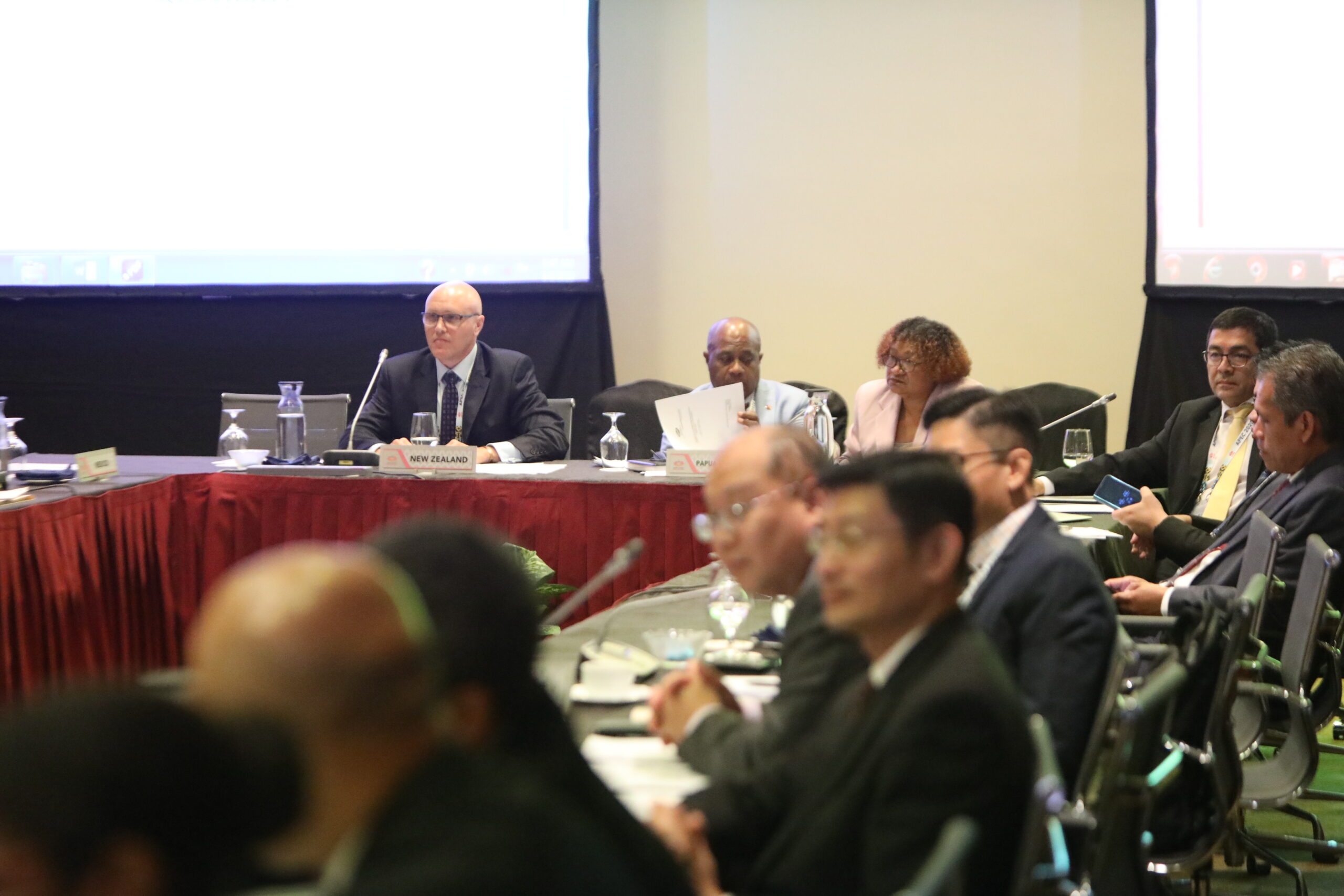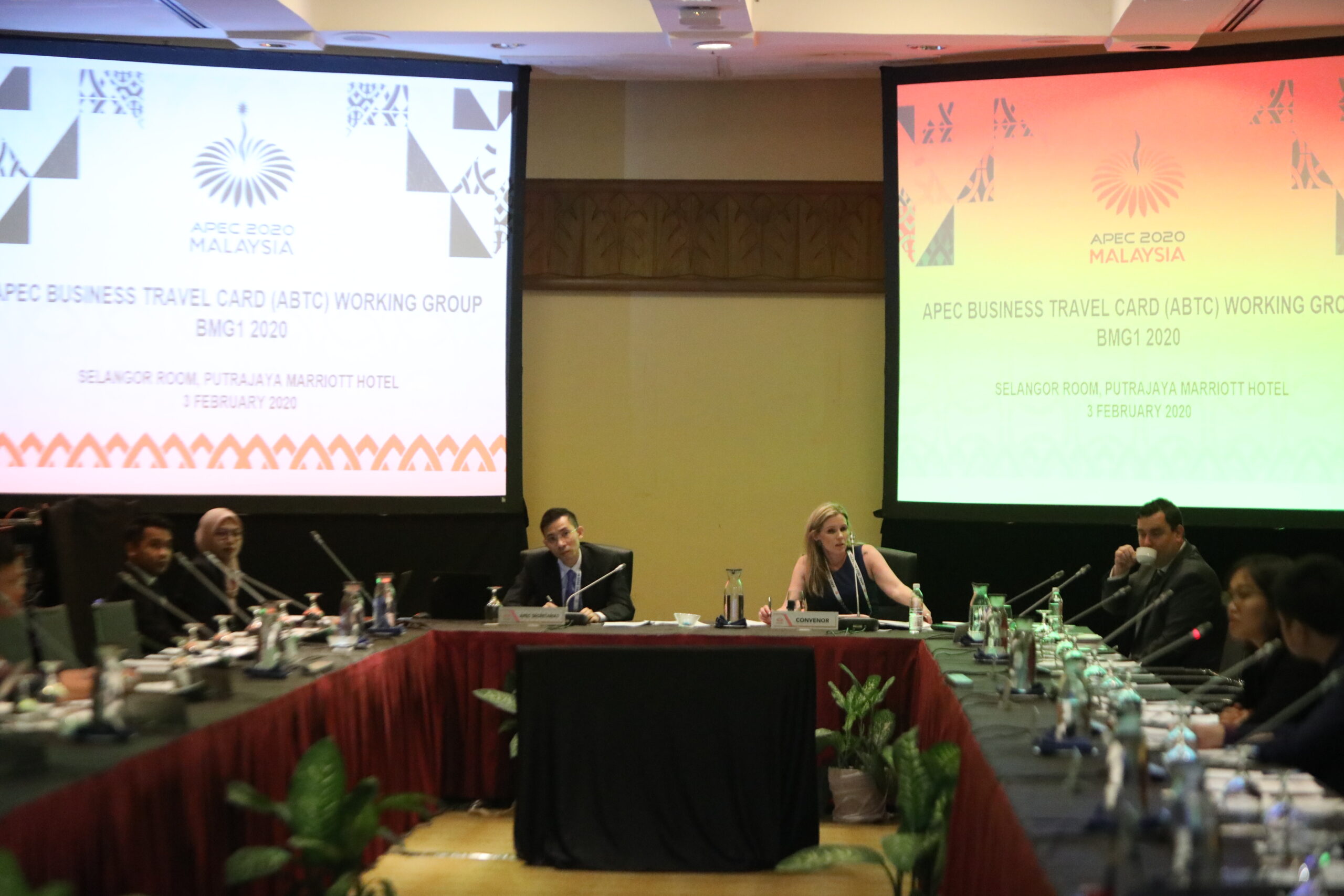The APEC Business Travel Card
The APEC Business Travel Card (ABTC) scheme was developed to provide the region’s business community with easier access to other economies in the Asia-Pacific region. The ABTC supports APEC goals of business development, trade and investment through the facilitation of travel between economies.
Currently of the 21 participating economies, 19 are full members which issue cards to their own citizens and provide pre-clearance approval and fast-track lane access to business travellers from other economies[1]. The United States and Canada are transitional members who participate in all aspects of the scheme except they do not issue pre-clearances in advance and instead still require ABTC holders to present at the border any visas, travel or other entry documents that are required for entry. Fully participating economies benefit from a reduced burden on at-the-border security resources because ABTC holders are screened by all economies to ensure they are low-risk travellers [2].
The ABTC is valid for five years and permits eligible businesspeople with legitimate business travel needs to travel without the need for separate visa applications in fully participating economies and provides access to priority fast track lanes at border immigration inspection facilities in all economies. Thus, the card aims to save cardholders considerable money in terms of visa fees and considerable time in terms of border entry processing. The scheme reduces travel costs between APEC economies by 38% for cardholders [3]. Businesses pay 27% less in application fees and 52% less in immigration processing. This increases the ability of businesspeople to travel internationally [4]
Video Credit: APEC Secretariat

Photo Credit: APEC Secretariat
Context-development of the APEC Business Travel Card
Australia, Korea, and the Philippines were the three original members of the scheme when it was first trialled in 1997. The ABTC aimed to support APEC’s objectives of regional economic integration and the facilitation of regional trade and investment by reducing the costs of cross-border trade and the movement of people across borders. It is this strong alignment with APEC’s objectives that encouraged economies to support the scheme initially.
The design of the ABTC scheme also allowed economies to signal interest and agree in principle to the scheme without needing to sign up initially. Economies with hesitations around the scheme or domestic regulation which hindered immediate participation were able to monitor the progress of the scheme and sign up when the economy was comfortable to do so. Early adopters of the scheme tended to be economies that already had high levels of visa free arrangements which meant the risk to sign up for the scheme was reduced. However, this also meant that initial participation in the scheme from those economies was lower as there was less need for a citizen to apply for a card if the economy they were travelling to already allowed visa free access. In comparison, economies which viewed the scheme as a greater threat to border security waited to observe the success of the scheme before signing up but found greater value in participation.
Some economies were able to join the scheme quicker than others. For economies like Peru, who approved its incorporation into the scheme in 2000, a coordinated effort was required between relevant domestic authorities to create regulation so that the economy would be able to participate in the scheme. It was officially implemented in 2003. Included in this regulatory change was the necessary work on how Peru would decide the criteria for a businessperson, determining who would be eligible for the scheme. The ABTC Operating Framework maintains a broad definition of a businessperson which ensures economies can offer eligibility and flexibility to a wide range of people under its own domestic laws and policies. Individual economies are responsible for further clarifying the definition which can mean some travellers are ineligible.
There were some reservations with the scheme when it first launched. The criteria that must be met to apply for the ABTC, coupled with the requirement that each economy individually approve the cardholder meant that the approved participants were low risk.
Characteristics of the ABTC Cooperation
To receive an ABTC, applicants who meet the criteria must make a single application to the economy for which they hold a passport or have permanent residence (in the case of Hong Kong, China). If this economy assesses the application as meeting the relevant criteria, the applicant’s details are provided to the other participating economies who conduct their own assessment of whether to grant pre-clearance. When all economies have made a pre-clearance decision, the applicant receives an ABTC that lists the economies to which they have permission to travel. The work is shared between economies as each is responsible for managing the processing of their own pre-clearance applications and no economy has any influence over the processing timeframes of another. The ABTC Operating Framework provides that pre-clearance processing times are expected to be kept as short as possible and that pre-clearance should be completed within 2-3 weeks of economies receiving the request. However, processing of the application can generally take much longer, 3-6 months on average. Applicants are able to receive an interim card which is sent out once the five priority economies that the applicant has self-selected have provided clearance which helped to partially reduce the long waiting times cardholders were experiencing.
Canada and the United States are transitional members. This means they participate in some, but not all aspects of the ABTC scheme. While transitional members do not participate in the preclearance portion of the scheme, they do issue ABTCs to their own citizens so that they can utilize fast-track passenger processing lanes in other economies. The United States offers foreign cardholders expedited visa appointments, when feasible, and access to specialized passenger processing lanes upon arrival.
The ABTC gives frequent business travellers fast-track entry and exit through special APEC lanes at participating airports and, for cardholders of fully participating members, multiple short-term entries to precleared APEC economies without having to make a separate visa application to fully participating members.

Photo Credit: APEC Secretariat

Photo Credit: APEC Secretariat
Assessment
Benefits of the APEC Business Travel Card vary between economies
The advertised benefits of the ABTC are attractive for business travellers seeking to regularly travel within the Asia-Pacific region. ABTC holders are able to travel to economies that are full members of the scheme for business purposes without needing to pay for and take the time to submit separate visa applications each time they travel. This reduces the expense for businesses collaborating and trading within the Asia-Pacific region, particularly for those who travel frequently for business.
Separate APEC cardholder lanes at airports aim to reduce waiting times when travelling and provide a smoother experience. Peru and Chile specifically noted businesspeople appreciate the special entry lanes for the quicker transit times through the airport, which makes it easier to schedule business meetings. While quicker movement through airports is attractive for busy business travellers, this benefit is not necessarily guaranteed. At busy airports, cardholders waiting in the specific lane can spend just as long, or even longer waiting to be processed than travellers using the regular lanes. Additionally, infrequent travel by ABTC members through certain airports can result in cardholder lanes being neglected as it is less cost effective to keep the lane constantly staffed. Greater levels of communication and training for border officers has been pinpointed as an effective way to reduce these issues, particularly in smaller airports where ABTC holders are less common.
The popularity of a scheme can depend on the advantages offered to participants. Variations in the extent to which it benefits certain groups can lead to inequal participation rates between economies. In the case of the ABTC, economies which already have visa free travel schemes with a greater number of economies see less benefit from the scheme and tend to have lower rates of participants. For example, Singaporean citizens tend to already have visa free access to many economies so participants in the scheme may use the card mainly for the fast-track lanes at airports rather than for the visa component. In comparison, Peruvian citizens would ordinarily need to obtain visas to access many APEC economies, so the multi-economy visa access provides a clear and valuable benefit to Peru cardholders and the Peru economy as this reduces the need to process individual visas for each entry and exit.
Economies may have different views on the advantages of a scheme, depending on the level of effort required. ABTC preclearance application processing requires significant resourcing, even though economies may not see a reward from this work if the applicants never visit their economy. This is especially an issue for smaller economies such as Papua New Guinea and New Zealand. In 2014, Papua New Guinea received only 500 cardholder visits and roughly 900 cardholders visited New Zealand[2].
Peru noted that large volumes of applications can place a burden on the workforce, especially as it can be difficult to source workers with skills in this area.
Challenges of the ABTC Scheme
A common challenge expressed by both economies and clients is the length of time it takes for cardholders to receive pre-clearance approval from all 19 economies participating in the ABTC scheme. The average length of time for this process is three months, however, longer wait times are not uncommon and in some instances, approval can take up to a year. The ABTC Operating Framework sets an expectation of pre-clearance being completed within two – three weeks of receiving a request.
Although e-Government services continue to expand rapidly across the region as the virtual ABTC is rolled out, ABTC applications remain largely paper-based, which requires economy staff to manually enter all data into the ABTC system. Manual entry increases the likelihood of application errors which will need to be followed up. The increase in the duration of the card from 3 to 5 years has eased some of the resourcing burdens on economies due to the reduced frequency of reapplications.
Other challenges for governments include providing greater application process transparency and support for applicants, safeguarding client data, improving ABTC system functionality, achieving parity in technical capabilities of economies, and clarifying acceptable uses of the card.
There is also a perception that the process of reapplication for a card after expiry is redundant. Current cardholder applicants are less likely to pose any security risks yet further time and money must be spent by cardholders and APEC economies to go through the process again after the expiry of a card. This demonstrates the disconnect between economy processing staff, who view the ABTC as a travel document similar to a passport or visa, and cardholders, who view the card as a convenience that applicants must go through a strenuous process to receive.

Photo Credit: APEC Secretariat

Photo Credit: APEC Secretariat
Lessons Learned
The Virtual ABTC will be a quicker, more efficient tool for economies and cardholders. The Virtual ABTC was launched by the APEC Business Mobility Group during the APEC Leader’s Week in November 2020. The Virtual ABTC displays a digital version of the card on a mobile application which cardholders can present to enter an APEC economy. Security measures are included in the app to prevent fraudulent duplication and misuse.
On 1 March 2021, Australia transitioned to the Virtual ABTC and now offers it to approved Australian cardholders. While the intention is for the Virtual ABTC to eventually replace the physical version, each economy will determine its own timeline for transitioning. As transitional members, Canada and the United States will not have the ability to access the virtual ABTC at this time.
The developers of the virtual card have used the lessons learned from the physical card to create a card that is more secure, efficient, convenient and user-friendly, particularly as APEC members are looking for safe and effective measures to open up borders and resume international travel.
A major inconvenience with the physical card was the lengthy wait times for using the card. The new virtual card has removed this issue and provides a quicker service. When each economy approves the application, that economy will appear on the app and cardholders will then be able to use the card to access that economy. This reduces the length of time cardholders need to wait between submitting their application and being able to use their card. Peru noted that updated real-time information on the status of the virtual card has been a major benefit.
A benefit for economies is that they will no longer need to expend resources printing and sending physical cards. For Australia, this was a major benefit for transitioning to the virtual card, particularly as Australia used to print physical cards for other economies that did not have the necessary resources. Australia’s transition to the virtual card, and subsequent decision to stop printing cards, has encouraged those economies to transition to the virtual card as well. Chile has also noted that processing times for cards are quicker since its transition to the virtual card.
The new virtual card has the same design as the physical card, to help economies and cardholders understand and feel comfortable using the virtual card. This has meant that economies would not need to spend extra time retraining staff as the process at the border works much the same. While some economies would prefer extra security measures such as QR code, the design team recognised that it would be difficult to install specialist security software across all economies. Peru noted that not all cardholders are proficient users of technology and applications, and this can cause issues in the short term.
Next Steps
To date, the roll out of the virtual card has been hampered due to worldwide border restrictions restricting travel between economies. However, developers are confident that the benefits of the virtual card will encourage economies to transition, and that cardholders themselves will champion this change.
Endnotes
[1]APEC (n.d.), APEC Business Travel Card Goes Digital, https://www.apec.org/Press/News-Releases/2021/0304_ABTC.
[2] Tetlow, J. and C. Wood (2014), “Supporting Continued Growth in Trade and Facilitation: End to End Review of the APEC Business Travel Card”, Washington: APEC Business Mobility Group.
[3]APEC (n.d.), APEC Business Travel Card (ABTC), https://www.apec.org/Groups/Committee-on-Trade-and-Investment/Business-Mobility-Group/ABTC.
[4]Part of the information in the case study above has come from discussions with a variety of economies including Australia, Canada, Chile, Peru, the United States and others.
Date : Finalised in 2022.